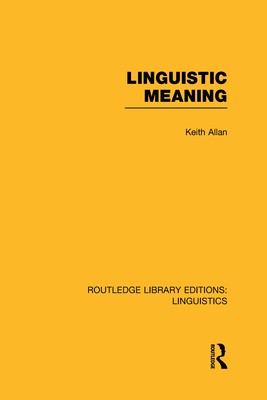
- We will send in 10–14 business days.
- Author: Keith Allan
- Publisher: Routledge
- ISBN-10: 0415715830
- ISBN-13: 9780415715836
- Format: 15.6 x 23.4 x 4.3 cm, hardcover
- Language: English
- SAVE -10% with code: EXTRA
Linguistic Meaning (Rle Linguistics A: General Linguistics) (e-book) (used book) | bookbook.eu
Reviews
Description
Dr Keith Allan presents a coherent, consistent and comprehensive account of linguistic meaning, centred around an informally presented theory of meaning. It is intended for graduate and undergraduate students of linguistics, or any linguist curious about what a theory of meaning should seek to accomplish and the way to achieve that aim.
The work assumes that the primary task of a theory of linguistic meaning is to describe the meaning of speech acts. This in turn presupposes a theory of semantics and a theory of prosodic meaning, as well as a proper treatment of the co-operative principle, context and background information. These matters are dealt with in detail. The second task of a theory of linguistic meaning is to identify what meaning is, to explain the relationships between sense and denotation, and to explicate the nature of meaningful properties and meaning relations. These matters are fully covered, and the work concludes with a summary of the principle arguments presented.
EXTRA 10 % discount with code: EXTRA
The promotion ends in 20d.17:18:56
The discount code is valid when purchasing from 10 €. Discounts do not stack.
- Author: Keith Allan
- Publisher: Routledge
- ISBN-10: 0415715830
- ISBN-13: 9780415715836
- Format: 15.6 x 23.4 x 4.3 cm, hardcover
- Language: English English
Dr Keith Allan presents a coherent, consistent and comprehensive account of linguistic meaning, centred around an informally presented theory of meaning. It is intended for graduate and undergraduate students of linguistics, or any linguist curious about what a theory of meaning should seek to accomplish and the way to achieve that aim.
The work assumes that the primary task of a theory of linguistic meaning is to describe the meaning of speech acts. This in turn presupposes a theory of semantics and a theory of prosodic meaning, as well as a proper treatment of the co-operative principle, context and background information. These matters are dealt with in detail. The second task of a theory of linguistic meaning is to identify what meaning is, to explain the relationships between sense and denotation, and to explicate the nature of meaningful properties and meaning relations. These matters are fully covered, and the work concludes with a summary of the principle arguments presented.


Reviews